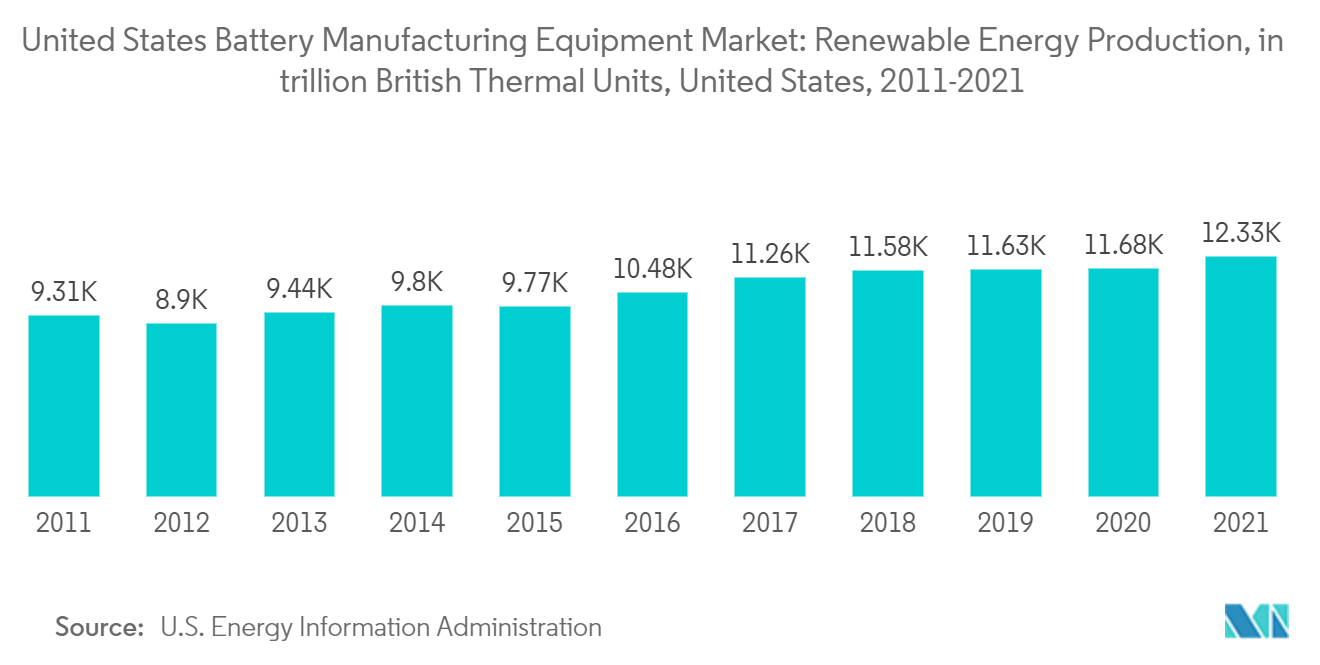Market Trends of United States Battery Manufacturing Equipment Industry
This section covers the major market trends shaping the US Battery Manufacturing Equipment Market according to our research experts:
Automotive Segment to Dominate the Market
- The United States has been attempting to reduce its carbon footprint. To fulfill its emissions target, the country has sanctioned several green programs. Furthermore, public awareness and pressure from numerous stakeholders have weighed in to follow the sustainable energy programs, which are predicted to enhance the country's battery manufacturing equipment market.
- Moreover, in recent years the demand for electric vehicles in the United States has grown significantly. According to International Energy Agency, the number of electric vehicles in the United States increased by 53.33 % in 2021 compared to 2020. In 2021 a total of 630,000 units of electric vehicles were sold, compared to 294,000 in 2020. A similar trend is expected to be followed during the forecast period, which indicates the increasing growth of the battery equipment manufacturing market.
- Additionally, as the demand for electric vehicles grows, automakers are developing electric vehicles of various forms and designs for all car categories to increase vehicle sales. This customization in automotive design presents a substantial growth opportunity for battery manufacturing to fulfill automobile manufacturers' expectations.
- Furthermore, in December 2022, General Motors and LG Energy Solution announced that they would spend an additional USD 275 million on their joint venture battery plant in Tennessee to increase production by more than 40%. The joint venture, Ultium Cells LLC, announced that the new investment is in addition to the USD 2.3 billion announced in April 2021 to build the 2.8 million-square-foot facility. Production at the plant is expected to begin in late 2023.
- Hence, the automobile segment is expected to dominate the market in the forecast period due to increased production, technological advancements, and supportive government policies for battery production, which drives the battery equipment manufacturing market.

Increasing Renewable Energy Projects Coupled with Battery Energy Storage System Expected to Drive the Market
- Over the last few years, installed renewable energy capacity and generation have steadily increased across the United States. Since renewable resources such as solar and wind generate power intermittently and at different levels, storing this energy during peak demand is critical. As a result, battery energy storage systems (BESS) are becoming essential to renewable energy projects. The rapid growth of the renewable energy sector is expected to be one of the country's most potent drivers of battery demand.
- Battery energy storage is considered a critical technology in transitioning to a sustainable energy system. The battery energy storage systems regulate voltage and frequency, reduce peak demand charges, integrate renewable sources, and provide a backup power supply. Batteries are crucial in energy storage systems and are responsible for around 60% of the system's total cost. This increase in BESS projects in the country is expected to increase the demands for batteries in the region.
- In 2021, the United States introduced the Federal Sustainability Plan (FSP), which outlines an ambitious path to power Federal facilities with 100 percent carbon pollution-free electricity (CFE), including 50 percent on a 24-hour-a-day, 7-days-a-week (24/7) basis. In order to achieve this ambitious target, the National Renewable Energy Laboratory (NREL), the national laboratory of the Department of Energy, expects a significant increase in solar and wind energy sources.
- According to the U.S. Energy Information Administration, the United States produced 12,317 trillion British thermal units of renewable energy in 2021, representing a 5.5% increase over the previous year.
- According to NREL, wind and solar energy are expected to provide at least 60 to 80% of power generation in the electricity mix by 2035. It is further estimated that the overall electricity generation will increase by three folds in 2035 compared to 2020, including two terawatts of wind and solar energy sources. This increase in renewable energy projects is expected to increase the demand for battery energy storage system which consequently will increase the demand for batteries.
- For instance, in December 2022, Mitsubishi Power Americas announced that they would supply batteries for the development of three battery energy storage systems in the southeast US. The three hybrid projects are being developed by Origis Energy as part of 1.5 GW of operational and contracted assets in the region.
- Therefore, owing to the above points, the increasing penetration of renewable energy coupled with battery energy storage systems is expected to drive the battery manufacturing equipment market in the United States.


